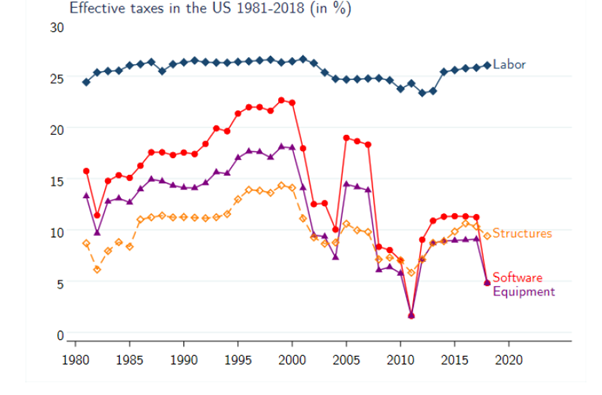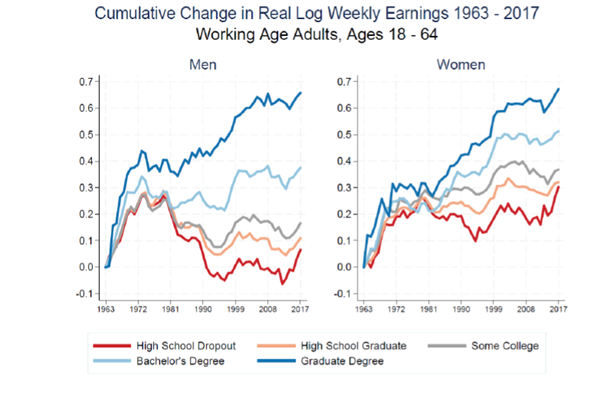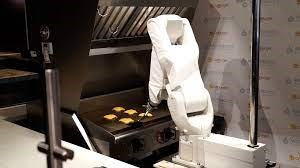This is the third in a series of posts on the future of work since the pandemic slump. Here is Part 1 The future of work 1: remote working and Part 2 The future of work 2: working long and hard
Michael Roberts is an Economist in the City of London and a prolific blogger
Cross-posted from Michael’s Blog

Photo: KUKA Systems GmbH licensed under the Creative Commons Attribution-Share Alike 3.0 Unported
In this third part of my series on the future of work, I want to deal with the impact of automation, in particular robots and artificial intelligence (AI) on jobs. I have covered this issue of the relationship between human labour and machines before, including robots and AI. But is there anything new that we can find after the COVID slump?
The leading American mainstream expert on the impact of automation on future jobs is Daron Acemoglu, Institute Professor at MIT. In testimony to the US Congress, Acemoglu started by reminding Congress that automation was not a recent phenomenon. The replacement of human labour by machines started at the beginning of the British Industrial Revolution in the textile industry, and automation played a major role in American industrialization during the 19th century. The rapid mechanization of agriculture starting in the middle of the 19th century is another example of automation.
But this mechanisation still required human labour to start and maintain it. The real revolution would be if automation became not just human controlled machinery, but also robots in manufacturing and software-based automation in clerical and office jobs that required not only less human labour, but could totally replace it. This form of automation started to happen from the 1980s as capitalists looked to boost profitability by shedding human labour in droves. Whereas, previous mechanisation not only shed jobs, often it also created new jobs in new sectors, as Engels noted in his book, The condition of the working class in England (1844) – see my book on Engels’ economics pp54-57.
Acemoglu reckons modern automation, particularly since the Great Recession and the COVID slump, is even more deleterious to the future of work. “Put simply, the technological portfolio of the American economy has become much less balanced, and in a way that is highly detrimental to workers and especially low-education workers.” He reckoned that more than half, and perhaps as much as three quarters, of the surge in wage inequality in the US is related to automation. “For example, the direct effects of offshoring account for about 5-7% of changes in wage structure, compared to 50-70% by automation. The evidence does not support the most alarmist views that robots or AI are going to create a completely jobless future, but we should be worried about the ability of the US economy to create jobs, especially good jobs with high pay and career-building opportunities for workers with a high-school degree or less.” His analysis of automation’s effects in the US also applied to the rest of the major capitalist economies.
The other significant conclusion that Acemoglu reached was that not all automation technologies actually raise the productivity of labour. “Those that reduce costs and boost productivity generate a set of compensating changes, for example, expanding employment in non-automated tasks. On the other hand, if automation is “so-so” — meaning that it generates only minor productivity improvements — then it creates all the displacement effects but little of the compensating benefits.” Indeed, as the US economy has shifted more and more into automation, it has gone less into socially beneficial types of automation. Indeed, Acemoglu reckons that the drive for extra profits from automation by leading companies can lower productivity growth. That’s because companies mainly introduce automation in areas that may boost profitability, like marketing, accounting or fossil fuel technology, but not raise productivity for the economy as a whole or meet social needs.
As Acemoglu explained to the US Congress: “American and world technology is shaped by the decisions of a handful of very large and very successful tech companies, with tiny workforces and a business model built on automation.” And while government spending on research on AI has declined, AI research has switched to what can increase the profitability of a few multi-nationals, not social needs: “government spending on research has fallen as a fraction of GDP and its composition has shifted towards tax credits and support for corporations. The transformative technologies of the 20th century, such as antibiotics, sensors, modern engines, and the Internet, have the fingerprints of the government all over them. The government funded and purchased these technologies and often set the research agenda. This is much less true today.”
In the US, software and equipment are taxed close to zero and in some cases, corporations can even get a net subsidy when they invest in such capital. This generates a powerful motive for ‘excessive automation’ where companies can save money when they install machinery to do the same jobs as workers and lay off their employees, because the government subsidizes their investments and taxes what they pay in wages.

The result of automation in the last 30 years has been rising inequality of incomes. There are many factors that have driven up inequality of incomes: privatisation, the collapse of unions, deregulation and the transfer of manufacturing jobs to the global south. But automation is an important one. While trend GDP growth in the major economies has slowed, inequality has risen and many workers — particularly, men without college degrees — have seen their real earnings fall sharply.

Even US treasury secretary Janet Yellen admitted that recent technologically driven productivity gains might exacerbate rather than mitigate inequality. She pointed to the fact that, while she reckoned that the “pandemic-induced surge in telework” might ultimately raise US productivity by 2.7%, those gains will accrue mostly to upper income, white-collar workers, just as online learning has been better accessed and leveraged by wealthier, white students. Indeed, increased online learning is another pandemic-induced technological shift that is likely to widen the educational achievement and productivity gap between upper-income children relative to those who are lower-income and minority.
Jobs that require less educational and technical skills will disappear and be replaced by those that do. The US Bureau of Labor Statistics (BLS) projects there will be 11.9 million new jobs by 2030, an overall growth rate of 7.7%. But while some sectors will expand jobs, others will be decimated.
These are fastest-growing occupations in the US.
| change, 2020–2030P | change, 2020-2030P | |
| Wind turbine service technicians | 68.2% | 4,700 |
| Nurse practitioners | 52.2% | 114,900 |
| Solar photovoltaic installers | 52.1% | 6,100 |
| Statisticians | 35.4% | 14,900 |
| Physical therapist assistants | 35.4% | 33,200 |
| Information security analysts | 33.3% | 47,100 |
| Home health and personal care aides | 32.6% | 1,129,900 |
| Medical and health services managers | 32.5% | 139,600 |
| Data scientists and mathematical science occupations, all other | 31.4% | 19,800 |
| Physician assistants | 31.0% | 40,100 |
Nine of the top 20 fastest growing jobs are in healthcare or related fields, as the baby by population ages and chronic conditions are on the rise. Home health and personal care workers who assist with routine healthcare tasks such as bathing and feeding, will account for million new jobs in the next decade. This will be almost 10% of all new jobs created by 2030. Unfortunately, these workers are the lowest paid on the list.
Then these are the occupations that will decline.
| change, 2020–2030P | change, 2020-2030P | |
| Word processors and typists | -36.0% | -16,300 |
| Parking enforcement workers | -35.0% | -2,800 |
| Nuclear power reactor operators | -32.9% | -1,800 |
| Cutters and trimmers, hand | -29.7% | -2,400 |
| Telephone operators | -25.4% | -1,200 |
| Watch and clock repairers | -24.9% | -700 |
| Door-to-door sales workers, news and street vendors, and related workers | -24.1% | -13,000 |
| Switchboard operators, including answering service | -22.7% | -13,600 |
| Data entry keyers | -22.5% | -35,600 |
| Shoe machine operators and tenders | -21.6% | -1,100 |
Eight of the top 20 declining jobs are in office and administrative support. These occupations currently make up almost 13% of employment in the US, the largest of any major category. Jobs involved in the production of goods and services, sales jobs, are also seeing declines. In all cases, automation is likely the biggest culprit. For example, software that automatically converts audio to text will reduce the need for typists. Seventeen of the top 20 fastest growing jobs have a median salary higher than $41,950 median salary for all jobs in total. Most also require post-secondary schooling. The opportunities are replacing jobs that only required a high school diploma.
That’s one aspect of the impact of automation on future work. The flipside of this is that automation and robots do not necessarily reduce the labour time involved in producing the things and services that modern societies need.
In March 2018, Flippy, a burger-flipping robot, was rolled out at the Pasadena location of fast-food chain CaliBurger, in California, to great fanfare and numerous headlines. But Flippy was retired after one day of work. CaliBurger’s owners blamed Flippy’s failure on their human employees: workers, they explained, were simply too slow with tasks such as dressing the burgers, causing Flippy’s meaty achievements to pile up. However, a few discerning journalists had previously noted Flippy’s numerous errors in the relatively simple task that gave the robot its name. Flippy just wasn’t very good at its job.

Investigating grocery store self-checkout, researchers found that customers hated and avoided the technology. In response, management cut staff to make lines so unbearable that customers gave up and used the machines instead. Even then, cashiers were still required to assist and monitor transactions; so rather than reduce workload, the technologies were intensifying the work of customer service. Self-checkouts are an example of how rather than abolishing work, automation proliferates it. By isolating tasks and redistributing them to others expected to do it for free, digital technologies contribute to overwork.

Indeed, AI regularly fails at tasks simple for a human being, such as recognizing street signs—something rather important for self-driving cars. But even successful cases of AI require massive amounts of human labour backing them up. Machine learning algorithms must be “trained” through data sets where thousands of images are manually identified by human eyes.
Getting AI systems to function smoothly requires astonishing amounts of “ghost work”: tasks performed by human workers who are kept away from the eyes of users, and off the company books. Ghost work is “taskified”—broken down into small discrete activities, “digital piecework” that can be performed by anyone, anywhere for a tiny fee.
Big Tech has a particular approach to business and technology that is centered on the use of algorithms for replacing humans. It is no coincidence that companies such as Google are employing less than one tenth of the number of workers that large businesses, such as General Motors, used to do in the past. This is a consequence of Big Tech’s business model, which is based not on creating jobs but automating them.
That’s the business model for AI under capitalism. But under cooperative commonly owned automated means of production, there are many applications of AI that instead could augment human capabilities and create new tasks in education, health care, and even in manufacturing. Acemoglu suggested that “rather than using AI for automated grading, homework help, and increasingly for substitution of algorithms for teachers, we can invest in using AI for developing more individualized, student-centric teaching methods that are calibrated to the specific strengths and weaknesses of different groups of pupils. Such technologies would lead to the employment of more teachers, as well as increasing the demand for new teacher skills — thus exactly going in the direction of creating new jobs centered on new tasks.”
There is also a more sinister aspect to AI. Employers have always tried to employ ‘big brother’ methods to control and discipline their workforces. Amazon is installing high-tech cameras inside supplier-owned delivery vehicles. Workers say the cameras are an invasion of privacy as well as a safety hazard. But Karolina Haraldsdottir, a senior manager of the last-mile delivery operation at Amazon, emphasizes that the cameras are meant “as a safety measure, intended to reduce collisions.” The company cited a pilot roll-out of the cameras from last year, which they say saw accidents drop by 48%.
Workers disagree. The installation of Driveri is in keeping with Amazon’s roll-out of similar camera monitoring among its long-haul trucking operation. “I am now driving around with an inscrutable black box that surveils me and determines whether I keep my job,” says a delivery driver in Washington. While he says he sees how, in theory, some of the metrics are justifiable — “you don’t want your drivers Tokyo Drifting through neighbourhoods” — in reality, aggregated on top of the layers of surveillance to which drivers already feel subject, it is “stifling, unnecessary, and ridiculous.” “We’re all just out here trying to do our best, but we also have to contend with knowing that each week, computers spit out metrics for us which require multiple pages to properly display, and a drop in those abstract numbers could lose us jobs,” he says. “All I want to do is deliver my damn packages and go home, man.”
Automation under capitalism means significant job losses among those without educational qualifications (education is now more and more expensive) and hits the lowest paid. Under capitalism, the aim is to boost profitability (and not even productivity, as much of automation can actually reduce productivity). And it is being used to control and monitor workers rather than help them achieve their tasks. Only the replacement of the profit motive could allow automation and robotics to deliver real benefits in shorter working hours and increased social goods.
Support us and become part of a media that takes responsibility for society
BRAVE NEW EUROPE is a not-for-profit educational platform for economics, politics, and climate change that brings authors at the cutting edge of progressive thought together with activists and others with articles like this. If you would like to support our work and want to see more writing free of state or corporate media bias and free of charge. To maintain the impetus and impartiality we need fresh funds every month. Three hundred donors, giving £5 or 5 euros a month would bring us close to £1,500 monthly, which is enough to keep us ticking over.


Be the first to comment